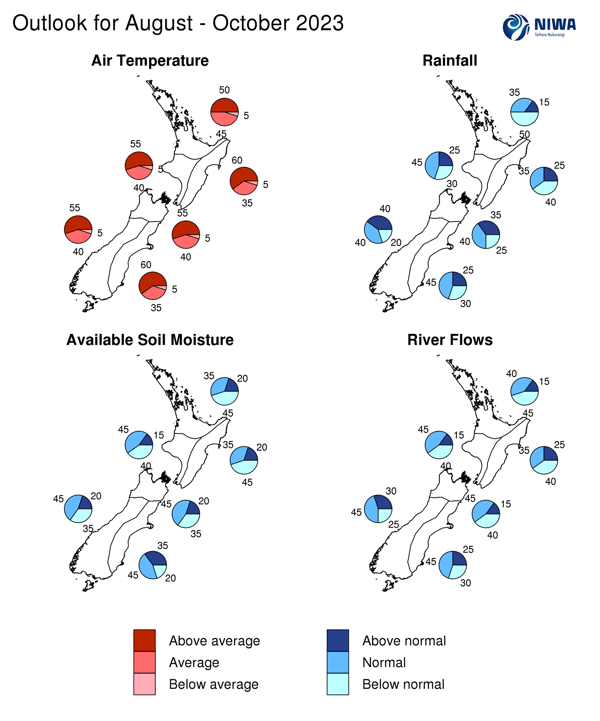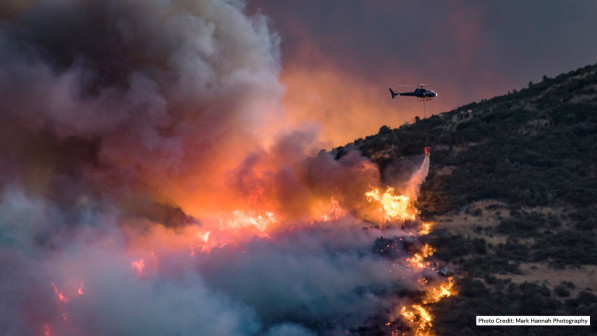This outlook highlights several critical climatic phenomena that are of particular importance: El Niño, Sea Surface Temperatures (SSTs), the Indian Ocean Dipole (IOD), the Madden-Julian Oscillation (MJO), and the Southern Annular Mode (SAM) which are detailed below.
El Niño: Characterised by warmer-than-average sea surface temperatures in the central and eastern equatorial Pacific Ocean, El Niño often leads to stronger and more frequent southwesterly winds in New Zealand. This may result in drier conditions in the northeast and wetter conditions in the southwest, influencing both temperatures and rainfall, thereby impacting the fire outlook. Significant subsurface anomalies of +5˚C to +7˚C were observed in the eastern equatorial Pacific Ocean. Upper-oceanic heat content was 2˚C to 2.5˚C above average, trending warmer since June, consistent with a developing El Niño event.
Sea Surface Temperatures (SSTs): Coastal SSTs around New Zealand ranged from 0.3˚C to 1.8˚C above average during July. Warmer seas can reduce the intensity of cold, southerly air masses that typically occur during late winter and spring. This may influence regional air temperatures and indirectly affect potential fire risks by altering weather patterns.
Indian Ocean Dipole (IOD): A positive IOD, marked by cooler than average seas northwest of Australia and warmer seas north of Madagascar, could reinforce El Niño’s effect on the atmosphere. This pattern has previously contributed to drier conditions in certain regions of New Zealand, potentially heightening fire risks.
Madden-Julian Oscillation (MJO): The MJO influences weather patterns by causing alternating periods of enhanced and suppressed rainfall in the tropics. In New Zealand, an MJO pulse may lead to higher than normal air pressure and below normal rainfall in certain areas during August, affecting the local fire outlook.
Southern Annular Mode (SAM): SAM describes the north-south movement of the westerly wind belt that circles Antarctica. A negative SAM may lead to stronger westerly winds over New Zealand, influencing weather patterns and potentially affecting fire risks in certain regions.
The following analysis explores the regional outlooks, reflecting on the forecast data, and provides insights into what these climatic factors could mean for fire risks in the upcoming summer season. Understanding these climate drivers and their potential impacts is essential for public safety, preparedness, and effective wildfire management.

Region Specific Forecast and Outlook
Northland, Auckland, Waikato, Bay of Plenty
Temperature and Rainfall: Above average temperature (50% chance) and below normal rainfall (50% chance).
Impact on Summer Fire Outlook: The projected drier and windier weather could lead to heightened fire risks in forested and grassland regions. Northland and Auckland, with their mixed terrains and history of wildfires, may face increased risks, particularly in areas that align with historical trends of dry conditions leading to wildfires. Coastal and hilly areas might present varied fire spread patterns, while Auckland's urban areas could be affected by increased wind speeds.
Central North Island, Taranaki, Whanganui, Manawatu, Wellington
Temperature and Rainfall: Above average temperature (55% chance) and near normal rainfall (45% chance).
Impact on Summer Fire Outlook: Above average temperatures might increase fire susceptibility in Wellington's bushland areas, while coastal regions may face elevated risks due to marine heatwave conditions. Taranaki's varied climate and forested areas could also experience increased fire risks. Geothermal regions and coastal areas could have specific fire scenarios, and Wellington's urban bushland areas may face increased fire risks.
Gisborne, Hawke’s Bay, Wairarapa
Temperature and Rainfall: Above average temperature (60% chance), equally likely below or near normal rainfall (40% chance, 35% chance).
Impact on Summer Fire Outlook: Gisborne and Hawke's Bay, known for their hilly terrains and agricultural lands, might see increased fire risks in farmlands. The developing El Niño and stronger seasonal wind speeds could exacerbate risks in Wairarapa's forested regions. Varied landscapes might affect fire spread and control, while proximity to populated areas could affect risks to property.
Tasman, Nelson, Marlborough, Buller
Temperature and Rainfall: Above average temperature (55% chance), equally likely near or above normal rainfall (40% chance, 35% chance).
Impact on Summer Fire Outlook: Marine heatwave conditions and westerly winds may create variable fire conditions in Nelson and Marlborough's vineyards and coastal areas. Tasman's bushland and Buller's mountainous regions may also face specific risks. Unique challenges may arise in bushland, coastal areas, vineyards, and alpine regions.
West Coast, Southern Alps and foothills, inland Otago, Southland
Temperature and Rainfall: Above average temperature (55% chance), equally likely near or above normal rainfall (40% chance).
Impact on Summer Fire Outlook: The West Coast's lush forests may be less susceptible, but inland Otago's dry grasslands and Southland's agricultural areas could face elevated risks due to increased winds and temperatures. Coastal plains to alpine foothills can influence fire spread, and proximity to populated areas may increase risks.
Coastal Canterbury and the nearby plains, east Otago
Temperature and Rainfall: Above average temperature (60% chance), near normal rainfall (45% chance).
Impact on Summer Fire Outlook: Coastal Canterbury's plains and east Otago's hilly regions may face specific risks due to frequent westerly winds. The mixed terrains might affect fire spread patterns, and urban areas like Christchurch may face specific challenges. Local fire history should be considered in understanding risks.
As New Zealand faces the coming months, the interplay of climatic phenomena such as El Niño, Sea Surface Temperatures, the Madden-Julian Oscillation, and the Southern Annular Mode paints a complex picture for the upcoming summer season. The regional variations in temperature, rainfall, soil moisture, and wind speeds reveal a nuanced landscape of potential fire risks across the country.
Understanding these risks is more than an academic exercise; it's a vital component in the preparation and planning needed to protect communities, natural landscapes, and the unique ecosystems of Aotearoa.
In this context, TracPlus remains committed to not only supporting wildfire response efforts but also enhancing their efficiency through our leading software solutions. By providing real-time tracking, communication, and operational insights, we empower firefighters and emergency responders to coordinate and act swiftly, reducing response times and making every mission more effective. Our technology is more than a tool; it's a partner in the mission to keep our communities safe.
